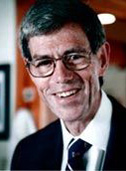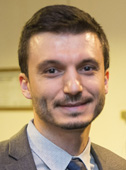The Transitional Practice of Surgery- a New Solution to a New Problem
John Cameron describes the remarkable changes in
the management and funding of orthopaedic surgical
care. “We had 108 beds for orthopaedic surgery when
I started at Toronto General. There are now only 9
beds for orthopaedic surgery in the Sunnybrook level 1
Trauma Unit. Patients in Nova Scotia wait one year to
see an orthopaedic surgeon and 4 years for an orthopaedic
operation.

John Cameron
|
John Cameron recalls
describing the transition
plan: “I said that it will
probably take 5 years. We
now realize that this can
be done very successfully
over a 2 year period. The
niche market in which
Sebastian and I operate is
the Osteotomy Program.
I ran a University of
Toronto Sports Medicine
Clinic for 33 years. I saw many young women with knee
problems; all showed a rotational deformity of the tibia,
which caused recurrent dislocation of their knee caps. I
devised an operation to cut the tibia and rotate it to correct
the deformity. It’s just a matter of carpentry with a
little biology and peroneal nerve care mixed in with it.”
John has been a mentor throughout his career. The list
of students that he has mentored is astounding. He got a
job at Toronto General and a $25,000 travel fellowship.
Fortunately, Dr. Harris was an insightful mentor who
secured a line of credit for him to allow him to travel and
enjoy this opportunity.

Sebastian Tomescu
|
“Sebastian and I have been doing this transition program
for 2 years. During the first year, Sebastian was my fellow;
during the past year, he
has been my partner. We
share an operating room
and have been working
on my 2 year waiting list.
We often operate together
which saves time. He
scrubs on complex cases,
and we work individually
on the simpler total knee
replacements. We run
parallel clinics and the
patients are happy to see either one of us. We know each
other’s patients and the patients are universally accepting
the transition plan, even those who have been followed
by me for many years. This is an example of transferred
trust. “One patient that I followed for 35 years and who
is still skiing black diamonds wrote a wonderful letter.
The follow-up is related to our policy of seeing our knee
replacement patients every 2 years with X- rays. We refer
to each other throughout the Orthopaedic Division. We
are also busy in our own individual niches, but it is a very
collaborative model.
“In contrast, when Bob Jackson, who brought arthroscopy
to North America –went to Baylor, no one referred
patients to him, despite his amazing contributions. Like
Bob Bell, I worked as a General Practitioner for 2 years
in Sudbury before entering orthopaedic surgery. I lived
at home and worked at 3 hospitals taking emergency
calls. This allowed me to be with my father during his
period of illness. Some of the senior surgeons at that
time were somewhat less than enthusiastic about transitional
arrangements.”
|
Sebastian trained in in the Competency - Based residency
program in orthopedic surgery in Toronto. John studied
engineering before entering the pre- Med Program.
“The transitional agreement was well written up by
Tom Blackwell in the National Post (1). If we in Toronto
transitioned 10 people per year, it would be a marvelous
solution to the placement problem. There are older doctors
whose savings were battered by the financial crisis
who are hanging on and are still practicing well past
traditional retirement age.” Sebastian says: “I’ve learned
a decade’s worth of practice in 2 years. The learning
curve is marvelously accelerated. In general, there is no
How to Practice course in a standard residency program.
” John’s administrative assistant Elizabeth Wood worked
with Sebastian and is now training Sebastian’s assistant.
There are many lessons apart from those learned in the
operating room about how to manage a clinic, how to
manage difficult families, how to reassure effectively.
All the patients in the transition program will become
Sebastian’s, but John will operate right up until his last
day, confident that their care will be uninterrupted as
Sebastian takes over.
“This is a good solution. The only challenge is to convince
seniors to retire. It is a great shame when an experienced
surgeon retires without a successor. All of that
knowledge and wisdom is immediately lost.” Currently,
the Department of Surgery asks new surgeons, including
Sebastian to sign a Memorandum of Agreement that has
a transition clause to become a mentor. The question
that a surgeon has to answer is When will I retire? Then,
the next question is: Who will I mentor for a practice
transition? This leads to thinking ahead about a rare and
extremely valuable question to address. It is a multiplying
and synergistic program. Currently, Obstetrics and
Acute Care Surgery group use an analogous collaborative
model informally. The patients have been remarkably
receptive. Surgeons are a little slower to adopt these
programs than patients are. Acceptance will improve
substantially through Surgeon Education and diffusing
the innovation.
MM
REFERENCES
1) Blackwell, T. Operation Job share: Surgeons Split Work to
Tackle ‘Unrelenting’ Problem of Unemployment. National
Post, Feb. 9, 2016 (http://news.nationalpost.com/news/ operation-job-share-surgeons-split-work-to-tackle-unrelenting- problem-of-unemployment)
2) Wakeam, E, Feinberg, S. Surgeon unemployment: Would practice
sharing be a viable solution?; Can J Surg 2016;59(2):141-
142
|